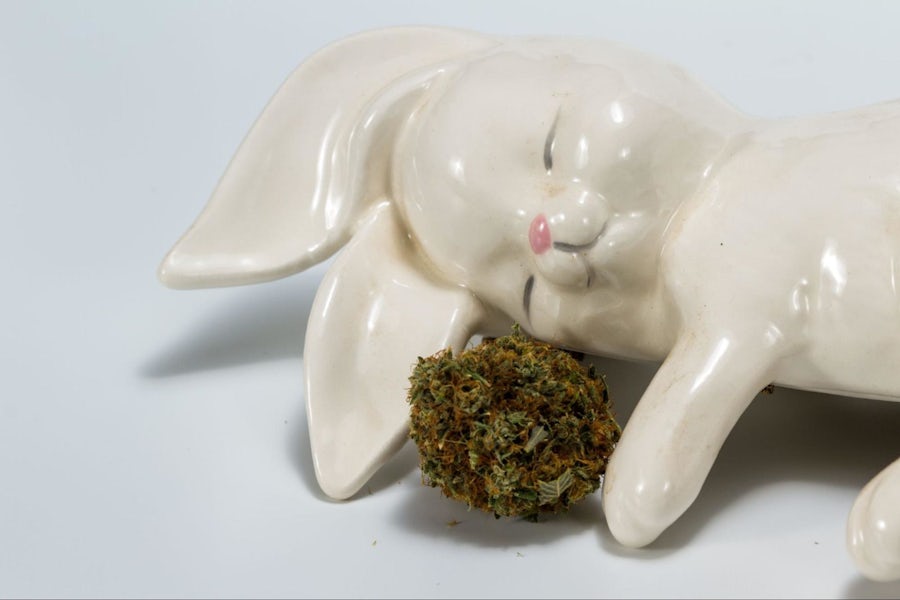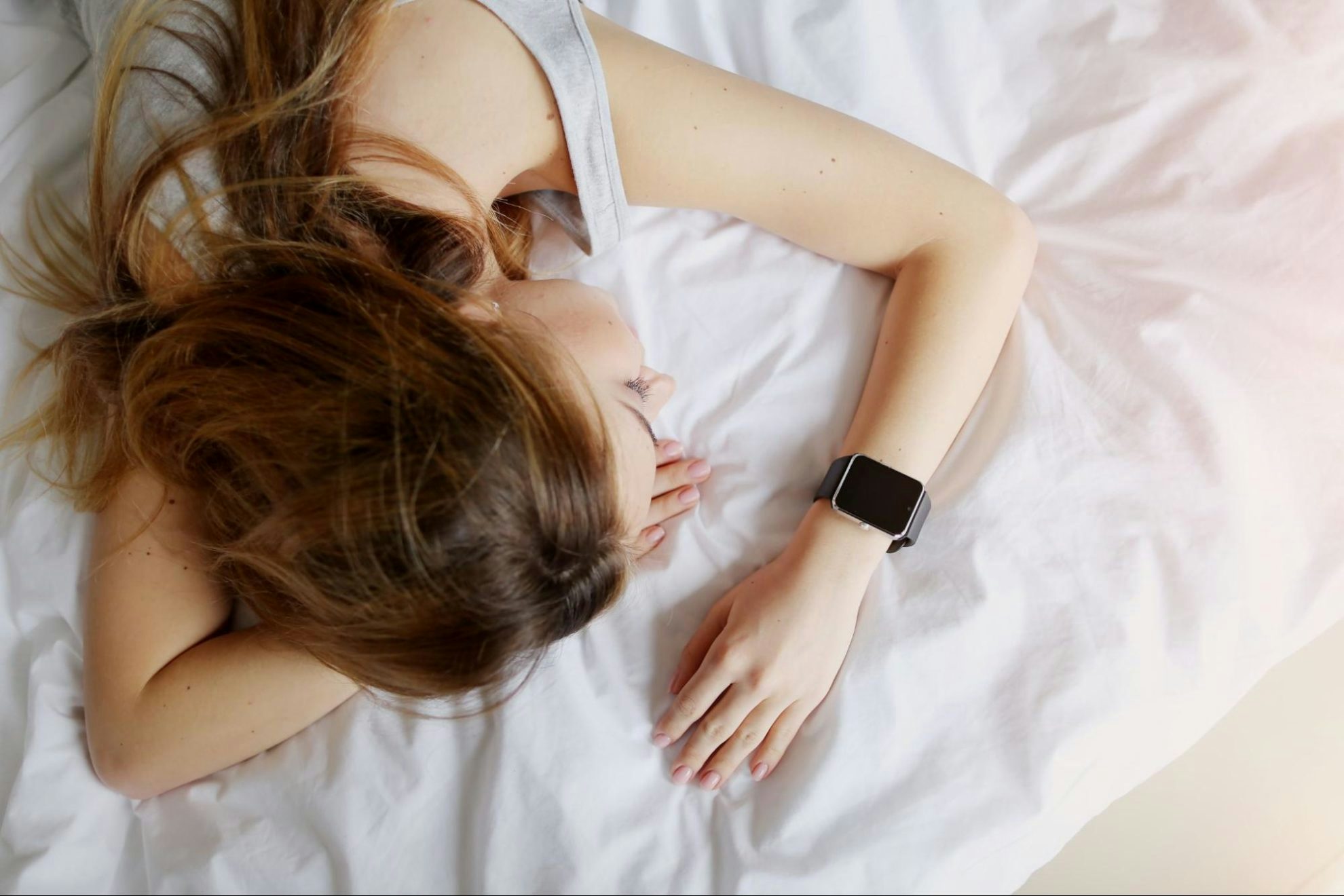If you’ve been poking around the internet or your local dispensary recently, you’ve likely come across edibles that include both cannabis and melatonin. As both of these substances are commonly used to help people sleep, it’s perhaps not surprising to see them combined. But it does raise an interesting question – what happens when you mix melatonin and weed?
Where you’ll see melatonin in cannabis products
Melatonin is included in some cannabis products, usually edibles, that are specifically marketed for sleep. You’ll usually see melatonin alongside CBD, THC, and/or CBN. The theory goes, that if THC can help you fall asleep, and CBD can help you stay asleep, adding in melatonin is the best of both worlds, right? Maybe, maybe not.
Is it safe to mix weed and melatonin?
Generally, yes. Both cannabis and melatonin are typically considered safe for consumption. However, everyone’s body and endocannabinoid system are different. If you don’t respond well to melatonin on its own, you probably won’t respond to it better by adding cannabis into the mix. The same is true if you don’t respond well to cannabis.
The other concern around these substances, both alone or together is that if used regularly they can alter our natural circadian rhythms, which could result in our suboptimal performance and health (like feeling tired, or dealing with excessive inflammation).
How melatonin works
Melatonin is an endogenous hormone, meaning it’s naturally produced in your body via the pineal gland. It is often referred to as a “sleep hormone” because its primary function is to regulate our circadian rhythms, although it is not essential for sleep. Melatonin is produced in response to darkness, synchronized with the light/dark cycle, so levels are low during daylight hours and reach peak levels during nighttime. Excess light at nighttime can block or alter natural melatonin levels, leading to a disruption in your sleep/wake cycle. 1 2
Melatonin production is regulated in the pineal gland by norepinephrine, a chemical that is both a hormone and a neurotransmitter. Norepinephrine plays an important role in controlling our wakefulness, including regulating natural melatonin release. Once melatonin is released by the pineal gland, it interacts with melatonin receptors found in certain parts of the body called M1 and M2. 3
Many people take melatonin supplements regularly for a variety of reasons, including general trouble sleeping, jet lag, and insomnia, although evidence supporting this is weak. A couple meta-analyses comparing melatonin to placebo show that melatonin may augment the natural process of reducing circadian arousal, helping people to fall asleep more quickly, but the benefit appears to be mild (about 4-12 minutes), which isn’t very compelling. 4
While melatonin isn’t actually FDA-approved (this goes for all supplements in the US), the use of melatonin is common and growing. A study published in 2022 found there was over a 500% increase in melatonin use between 1999 to 2018, with more than six million people taking the supplement. 5
Despite the lack of FDA approval, melatonin is generally considered safe by medical professionals. It is only associated with mild adverse events, but still should ideally only be used for short periods (three months or less). There are mixed opinions about how taking melatonin affects internal levels, but most evidence suggests there is not a significant disruption from use.
Sleep and the endocannabinoid system
So what does this have to do with cannabis? Your sleep cycle, like many of your biological functions, is also tied to your endocannabinoid system.
Like the sleep cycle, the ECS has a rhythm. A 2010 review of ECS and sleep studies concluded there is a “bidirectional relationship between endocannabinoid signaling and circadian processes.” Further, a 2015 rodent study found the endocannabinoid arachidonoyl ethanolamide (known as anandamide or AEA for short) “exerts time-dependent autocrine and/or paracrine functions within the pineal” – thus having an impact on your circadian rhythm. 6 7
The endocannabinoid system also plays a key role in regulating your norepinephrine system, which, as mentioned above, is an important regulator of melatonin production. 8
Phytocannabinoids like THC and CBD interact with CB1 and CB2 receptors in the endocannabinoid system. Both CB1 and CB2 receptors, as well as M1 and M2 receptors, fall into a group called G-protein coupled receptors. G-protein receptors are a large group of membranes that involve much more than these four receptors. But the categorization is important because one of the functions of G-protein receptors is to tell cells about the presence or absence of light. The absence of light, as mentioned above, triggers the production of melatonin (or should).
Additionally, a variety of factors including dose, tolerance, age, and gender, can affect your sleep cycle, but scientists are still evaluating how exactly cannabis changes sleep.
Drug interactions with melatonin and cannabis
THC and melatonin
THC use is known to alter the circadian rhythm and the sleep/wake cycle. Short-term use of THC can decrease sleep latency (the time it takes to fall asleep), increase time spent asleep, increase time in deep sleep and decrease REM sleep. But long-term use of cannabis disrupts the sleep/wake cycle and people often need higher and higher doses of THC to get the sleep-inducing effects. 9
Melatonin, on the other hand, is known for increasing REM sleep – at least in people with serious sleeping problems. This effect may explain why some users experience vivid dreams or nightmares while taking the hormone. 10
THC is known to have an inhibitory effect on dreaming, both reported by cannabis smokers, and also highlighted by vivid dreams. Whether or not these two substances work together to balance REM sleep is unknown.
So what might you feel if you take THC and melatonin together? Tired, lethargic, and sleepy. THC has a well known sedative effect, while melatonin affects sleep onset, so combining them may be a helpful combination to improve sleep. Use caution after taking it – you shouldn’t try to do anything besides head to bed. Sleepy mistakes or falls are all more likely when combining medications that induce drowsiness.
While combining melatonin and cannabis is generally considered safe, there is the potential for drug-drug interactions. Melatonin is metabolized by the cytochrome (CY) P450 enzymes in the liver, mainly CYP1A2. Smoking weed can alter this enzyme, leading to a more rapid metabolism of melatonin, reducing drug levels and minimizing its effect. Interestingly, smoking can induce CYP1A2 enzymes, and taking THC-infused edibles would not have this same effect. 11 12
CBD and melatonin
On its own, CBD seems to have a much milder effect on the sleep/wake cycle than THC. Low doses of CBD are reported to be wakeful and increase alertness, while high doses may cause sleepiness or sedation. 13
There is currently a clinical (human) trial underway, exploring the effects of a 20:1 CBD to THC oil on 20 people with chronic insomnia disorder. The study is not designed to understand the individual effects of CBD and THC, but rather to explore the effects of this specific dose during both daytime and nighttime. 14
Epidiolex, a prescription CBD medication for seizures, has both insomnia and sleepiness listed as potential side effects, highlighting the differences that each individual’s ECS plays in this process.
Taking a CBD product with melatonin likely won’t produce the same level of sedation as THC, but you’ll likely still feel tired nonetheless. A combination of CBD and melatonin may result in high blood levels or longer-lasting effects of melatonin, as it is metabolized by CYP2C9 and CYP2C19, which CBD inhibits, resulting in higher levels of melatonin and more intense melatonin effects. Again, the effects might be minimal – at best. Hypothetically interaction could also be leveraged to reduce your dose of melatonin and achieve the same effects. 15
What to be aware of when mixing weed and melatonin
- Be thoughtful about timing. If you’re taking an edible more than once, aim for the same bedtime and sleep routine. This consistency helps your body know when it’s time to wind down and get some rest, while novelty can increase alertness and brain activity.
- Use sparingly. Ultimately, cannabis and melatonin can impact your natural sleep cycle, and both can result in dependency to fall asleep. Tolerance to these substances can lead you to increase the dosage you take in order to get the desired results, which isn’t good for your body long-term. Take tolerance breaks as needed to ensure your brain isn’t becoming dependent on outside substances to trigger a natural process.
- Start with a low dose of melatonin and THC. Melatonin can cause strange dreams or even nightmares in some people while high amounts of THC can lead to trouble waking up or next-day grogginess. Combining these two substances means you should take a lower dose of each to let them work in tandem and avoid negative side effects. 16
Can you smoke weed and take melatonin?
The short answer is yes, you can, but it may not be the best method of administration.
While you can smoke a joint and take melatonin pills, the most common way to see these substances combined is in edibles. Edibles can take up to 90 minutes to kick in, though fast-acting edibles are reported to kick in after 20-40 minutes. Many people prefer edibles for bedtime because you can take one and go about your nighttime routine before it kicks in. The effects also last about 6-8 hours, providing long-lasting relief for the duration of sleep, and minimizing the need to re-dose. The discrete nature of edibles also makes them preferable for parents or people who can’t or don’t want cannabis smoke lingering.
Bottom line on cannabis and melatonin
Can you mix weed and melatonin? Yes, you can. Can combining weed and melatonin kill you? No, not likely. Cannabis has never killed anyone and melatonin is considered generally safe. Since both substances can help with sleep, combining them may improve their efficiency.
However, there is a caveat here – melatonin and cannabis should not be used or mixed every night. Becoming dependent on any substance to sleep can be problematic. However, for those with serious sleep issues, melatonin and cannabis can be useful when consumed mindfully. Should you take heaps of melatonin and cannabis together every night? No, probably not. But if you’re facing a long, sleepless night? Sure, a small dose of melatonin and cannabis should help you knock right out.
Sources
- Savage RA, Zafar N, Yohannan S, et al. Melatonin. [Updated 2022 Aug 8]. In: StatPearls [Internet]. Treasure Island (FL): StatPearls Publishing; 2022 Jan-. Available from: https://www.ncbi.nlm.nih.gov/books/NBK534823/
- Wagner G, Brandstätter R, Hermann A. Adrenergic and cholinergic regulation of in vitro melatonin release during ontogeny in the pineal gland of Long Evans rats. Neuroendocrinology. 2000 Sep;72(3):154-61. doi: 10.1159/000054582. PMID: 11025409.
- Carvalho AF, Van Bockstaele EJ. Cannabinoid modulation of noradrenergic circuits: implications for psychiatric disorders. Prog Neuropsychopharmacol Biol Psychiatry. 2012;38(1):59-67. doi:10.1016/j.pnpbp.2012.01.008
- Buscemi N, Vandermeer B, Hooton N, et al. The efficacy and safety of exogenous melatonin for primary sleep disorders. A meta-analysis. J Gen Intern Med. 2005;20(12):1151-1158 ; Brzezinski A, Vangel MG, Wurtman RJ, et al. Effects of exogenous melatonin on sleep: A meta-analysis. Sleep Med Rev. 2005;9(1):41-50.
- Li J, Somers VK, Xu H, Lopez-Jimenez F, Covassin N. Trends in Use of Melatonin Supplements Among US Adults, 1999-2018. JAMA. 2022;327(5):483–485. doi:10.1001/jama.2021.23652
- Vaughn LK, Denning G, Stuhr KL, de Wit H, Hill MN, Hillard CJ. Endocannabinoid signalling: has it got rhythm? Br J Pharmacol. 2010 Jun;160(3):530-43. doi: 10.1111/j.1476-5381.2010.00790.x. PMID: 20590563; PMCID: PMC2931554.
- Koch M, Ferreirós N, Geisslinger G, Dehghani F, Korf HW. Rhythmic control of endocannabinoids in the rat pineal gland. Chronobiol Int. 2015;32(6):869-74. doi: 10.3109/07420528.2015.1041596. Epub 2015 Jun 10. PMID: 26061461.
- Wyrofsky RR, Reyes BAS, Zhang XY, Bhatnagar S, Kirby LG, Van Bockstaele EJ. Endocannabinoids, stress signaling, and the locus coeruleus-norepinephrine system. Neurobiol Stress. 2019 May 25;11:100176. doi: 10.1016/j.ynstr.2019.100176. PMID: 31236436; PMCID: PMC6582240.
- Kesner AJ, Lovinger DM. Cannabinoids, Endocannabinoids and Sleep. Front Mol Neurosci. 2020 Jul 22;13:125. doi: 10.3389/fnmol.2020.00125. PMID: 32774241; PMCID: PMC7388834.
- Dieter Kunz, Richard Mahlberg, Cordula Müller, Amely Tilmann, Frederik Bes, Melatonin in Patients with Reduced REM Sleep Duration: Two Randomized Controlled Trials, The Journal of Clinical Endocrinology & Metabolism, Volume 89, Issue 1, 1 January 2004, Pages 128–134, https://doi.org/10.1210/jc.2002-021057
- Grant, I., Atkinson, J. H., Gouaux, B., & Wilsey, B. (2012). Medical marijuana: clearing away the smoke. The open neurology journal, 6, 18–25. https://doi.org/10.2174/1874205X01206010018
- Hardeland R. (2010). Melatonin metabolism in the central nervous system. Current neuropharmacology, 8(3), 168–181. https://doi.org/10.2174/157015910792246244
- Murillo-Rodríguez E, Sarro-Ramírez A, Sánchez D, Mijangos-Moreno S, Tejeda-Padrón A, Poot-Aké A, Guzmán K, Pacheco-Pantoja E, Arias-Carrión O. Potential effects of cannabidiol as a wake-promoting agent. Curr Neuropharmacol. 2014 May;12(3):269-72. doi: 10.2174/1570159X11666131204235805. PMID: 24851090; PMCID: PMC4023456.
- Suraev A, Grunstein RR, Marshall NS, D’Rozario AL, Gordon CJ, Bartlett DJ, Wong K, Yee BJ, Vandrey R, Irwin C, Arnold JC, McGregor IS, Hoyos CM. Cannabidiol (CBD) and Δ9-tetrahydrocannabinol (THC) for chronic insomnia disorder (‘CANSLEEP’ trial): protocol for a randomised, placebo-controlled, double-blinded, proof-of-concept trial. BMJ Open. 2020 May 18;10(5):e034421. doi: 10.1136/bmjopen-2019-034421. PMID: 32430450; PMCID: PMC7239553.
- Kocis, P. T., & Vrana, K. E. (2020). Delta-9-Tetrahydrocannabinol and Cannabidiol Drug-Drug Interactions. Medical cannabis and cannabinoids, 3(1), 61–73. https://doi.org/10.1159/000507998
- Goodhines PA, Gellis LA, Ansell EB, Park A. Cannabis and alcohol use for sleep aid: A daily diary investigation. Health Psychol. 2019 Nov;38(11):1036-1047. doi: 10.1037/hea0000765. Epub 2019 Jun 6. PMID: 31169378; PMCID: PMC6800769.
Sign up for bi-weekly updates, packed full of cannabis education, recipes, and tips. Your inbox will love it.

 Shop
Shop Support
Support




















The Cannigma , is one of my favorite cannabis wedsites to gain knowledge for medical cannabis!